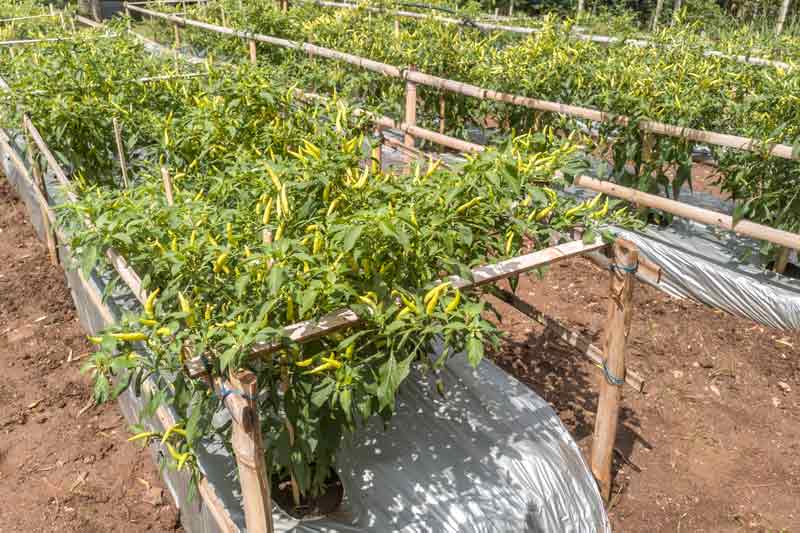Peppers that grow upwards offer a visual and practical twist compared to traditional downward-hanging varieties. Their unique growth pattern enhances garden aesthetics, making them stand out as natural decor and simplifying harvesting by keeping the fruits visible and away from soil-borne pests. Ideal for both culinary use and ornamental appeal, these upward-facing peppers, such as the vibrant Chinese 5-Color and the fiery Tabasco, add color and convenience to gardening, making them a favored choice for gardeners looking to combine beauty with functionality.
Understanding Upward-Growing Peppers
Genetic Foundations and Evolutionary Benefits
Upward-growing peppers, a marvel of genetics, have evolved to maximize sun exposure and facilitate seed spread. This adaptation not only aids in the plant’s survival by attracting pollinators but also enhances seed dispersal through animal interaction, showcasing nature’s ingenuity in ensuring the prosperity of species.
A Spectrum of Heat and Versatility
The world of upward-growing peppers is rich in diversity, spanning from the subtly mild to the scorchingly hot. This range makes them invaluable in the culinary landscape, where they’re celebrated for their ability to transform dishes with their vibrant flavors and colors. Gardeners, too, prize these peppers for their ornamental potential, leveraging their unique growth pattern and vivid hues to add aesthetic appeal to gardens and containers.
Popular Upward-Growing Pepper Varieties
Dive into the vibrant world of upward-growing peppers, where each variety boasts its unique flair and flavor profile.
Asian Peppers: A Culinary and Visual Spectacle
Asian peppers are renowned for their vibrant colors, diverse heat levels, and unique culinary uses, making them a favorite among gardeners and chefs. This section explores
some of the most popular upward-growing varieties from Asia.
Thai Peppers
Known for their fiery heat, Thai peppers rank high on the Scoville scale. They come in red, orange, and yellow hues, adding a spicy kick to Southeast Asian curries and stir-fries. Their vibrant colors and intense flavor make them a culinary staple in dishes where heat is crucial.

Chinese 5 Color Peppers
This visually stunning variety transitions through five colors—from purple to cream, yellow, orange, and finally red—as they mature. They are a feast for the eyes and offer a medium heat level, making them versatile for a range of dishes. Their ornamental appeal and flavorful punch make them a dual-purpose favorite, enhancing gardens and gourmet dishes.
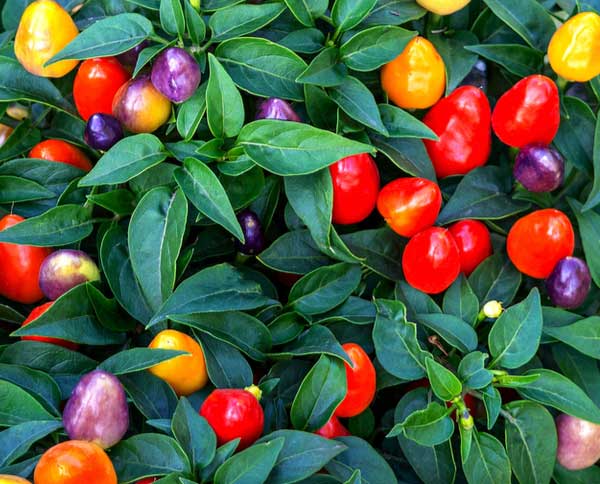
Japanese Santaka Peppers
A staple in Japanese cuisine, Santaka peppers are small but mighty, delivering a potent heat perfect for adding depth to sauces and seasonings. Their upward growth pattern and bright red color at maturity make them an attractive addition to any garden. At the same time, their spicy profile is ideal for culinary enthusiasts looking to bring authentic Japanese heat to their cooking.
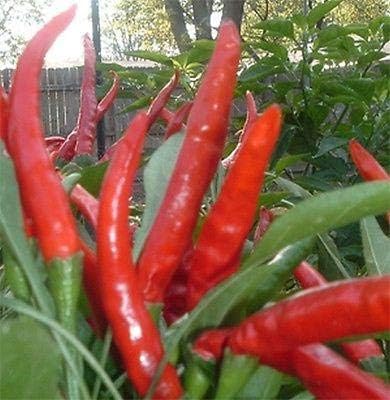
Siling Labuyo
From the Philippines comes the Siling Labuyo, a small but fiercely hot pepper. This tiny powerhouse packs a significant punch, with heat levels soaring high on the Scoville scale. Traditionally used in Filipino cuisine, Siling Labuyo is often found in spicy dishes, vinegars, and as a raw condiment. Its colors transition from green to a vibrant red as it matures, making it not only a culinary delight but also a visually appealing addition to gardens.
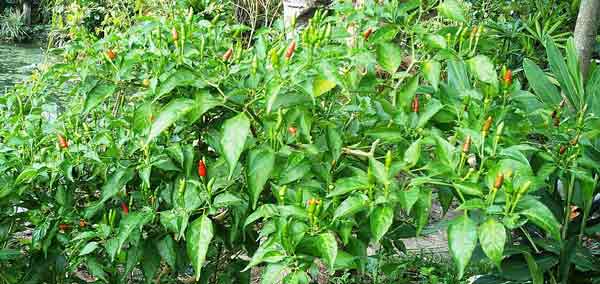
These Asian pepper varieties, with their upward growth habit, offer a unique combination of aesthetic appeal and culinary versatility. Whether used to spice up a favorite dish or to add a splash of color to the garden, these peppers embody a harmonious blend of form and function. Their inclusion in your garden or kitchen repertoire elevates the sensory experience and celebrates the rich tapestry of flavors and colors found in Asian peppers.
American Varieties
In the lush tapestry of the American pepper landscape, several varieties stand out, not just for their unique growth patterns but for the stories they tell and the flavors they bring to the table.
Mirasol: Gazing at the Sun
The Mirasol pepper, whose name poetically means “look at the sun,” perfectly encapsulates the essence of peppers that grow upwards. With fruits that point towards the sky, the Mirasol offers more than just a visual spectacle; it’s a culinary treasure as well. Used predominantly in Mexican cuisine, it’s the soul behind the famed Guajillo chili once dried, contributing deep, complex flavors to sauces and dishes.
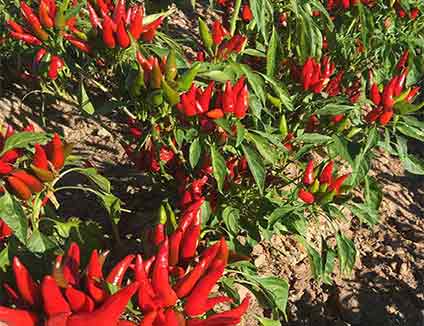
Tabasco: The Heatwave
No other pepper is as synonymous with spiciness as the Tabasco. Originating from the Mexican state of the same name, this pepper has risen to international fame through the iconic Tabasco sauce. With a heat level that packs a punch and a distinct, vinegary flavor, Tabasco peppers are a testament to the power of upward-growing varieties in influencing global cuisine.

Medusa Peppers: Twists of Color
Medusa peppers are known for their unique, curling fruits that resemble the mythical serpent’s hair, starting off as yellow and deepening to a rich red as they mature. Their visually captivating form and color progression make them an excellent choice for adding interest and variety to garden spaces and pots. Beyond their ornamental value, Medusa peppers offer a playful yet subtle heat that can be a delightful addition to dishes, making them a dual-purpose variety for those who appreciate both beauty and flavor in their gardening and culinary endeavors.
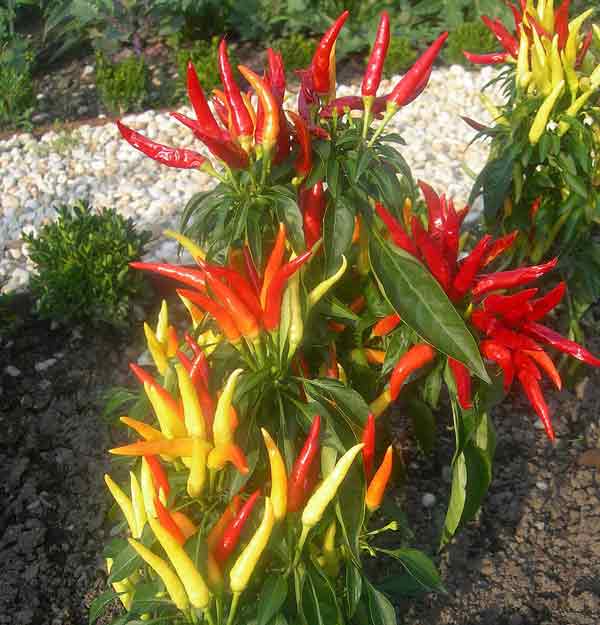
Halloween Peppers: A Festive Display
The Halloween pepper distinguishes itself with a dramatic transformation that captures the essence of its holiday namesake. Beginning as green, these peppers mature into a vibrant orange, embodying the spirit of Halloween. This striking color shift not only makes them a perfect thematic choice for autumnal garden displays but also adds a festive flair to culinary presentations. Their unique appearance is ideal for gardeners and chefs looking to bring a touch of seasonal whimsy to their creations.
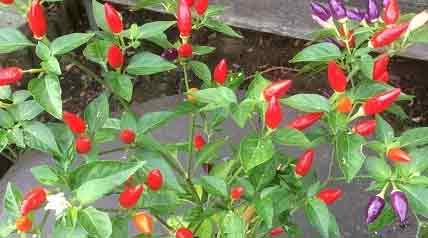
These American varieties underscore the diversity and versatility of upward-growing peppers. From the culinary dynamism of the Mirasol and Tabasco to the visual charm of ornamental types, these peppers enrich gardens and dishes alike, offering a slice of American horticultural heritage that’s as vibrant as it is flavorful.
Other Notable Varieties
Exploring the globe, we discover other remarkable pepper varieties that captivate with their unique shapes, flavors, and ornamental values. These varieties, hailing from diverse cultures and climates, offer a rich palette for both the culinary enthusiast and the garden decorator.
Alma Paprika: Hungary’s Sweet Heat
The Alma Paprika pepper from Hungary is a celebration of flavor and color. Renowned for its thick flesh and sweet taste, this pepper matures from creamy white through orange to a rich red, offering a spectrum of culinary uses. Primarily used for making paprika, it adds a gentle heat and a vibrant color to dishes, embodying the soul of Hungarian cuisine. Its round, cherry-like shape and robust growth make it a striking addition to any garden, blending culinary utility with decorative charm.
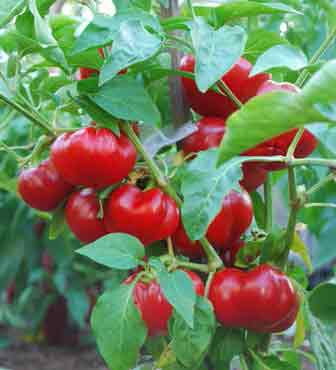
Brazilian Starfish: Exotic and Fiery
The Brazilian Starfish pepper, with its unique star-shaped fruit, originates from the warm climates of Brazil. This variety astonishes with its fruity flavor that has a sudden, sharp heat, making it a favorite among chili aficionados seeking a blend of taste and intensity. The Brazilian Starfish is not only a culinary delight but also a visually stunning plant, with its peculiar-shaped fruits adding an exotic touch to garden spaces and potted plant collections.
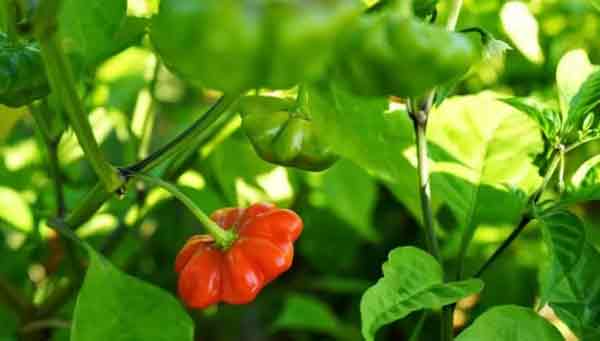
African Piri Piri: Spice That Travels
Lastly, the African Piri Piri (or Peri Peri) pepper is a small, fiery variety that has traversed oceans to become a global icon of spice. Known for its intense heat and pungent flavor, it’s the backbone of the famous Piri Piri sauce, a staple in Portuguese and African cuisines. Beyond its culinary fame, the Piri Piri pepper, with its upright growth and bright red fruits, serves as an attractive ornamental plant, bringing a dash of African sun to gardens and balconies.
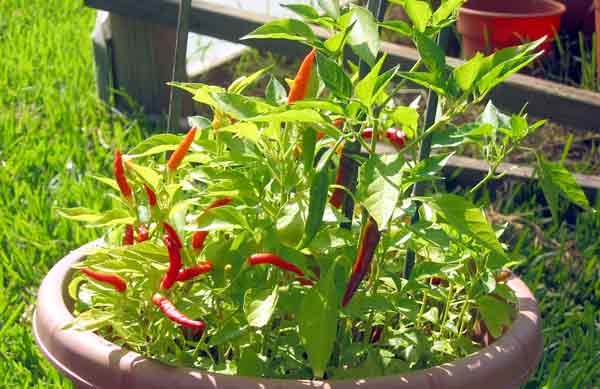
Each of these varieties, from the sweet Alma Paprika to the exotic Brazilian Starfish and the fiery African Piri Piri, not only enriches the culinary landscape with their distinct flavors but also adds a decorative flair to gardens and homes, showcasing the incredible diversity of upward-growing peppers. Their unique shapes and tastes remind us of the rich tapestry of cultures and cuisines around the world, inviting us to explore and celebrate the universal language of food and beauty.
Growing Tips for Upward-Growing Peppers
Cultivating upward-growing peppers is an art that harmonizes with science, requiring attention to soil quality, sunlight, watering routines, and proper potting to ensure these vibrant plants reach their full potential. Here’s how to nurture these beauties from seed to harvest with expert care.
Soil Preparation: The Foundation of Growth
Begin with well-draining soil rich in organic matter to foster robust root development. Upward-growing peppers thrive in a mix that balances moisture retention with adequate drainage, preventing waterlogging which can lead to root diseases. Incorporate compost or aged manure into your garden bed or potting mix to enrich the soil with essential nutrients, creating a fertile ground for your peppers to flourish.
Sun Exposure: Basking in the Glow
Peppers are sun worshippers, requiring at least 6 to 8 hours of direct sunlight daily to produce bountiful and vibrant fruits. Choose a sunny spot in your garden or a south-facing window for potted plants to ensure they receive ample sunlight. This not only boosts fruit production but also enhances the peppers’ flavor and color intensity.
Watering: The Balancing Act
Consistent moisture is key to growing healthy upward-growing peppers, but overwatering can be just as detrimental as under-watering. Aim for a steady watering schedule that keeps the soil evenly moist but not soggy. Mulching around the base of the plants can help retain soil moisture and regulate temperature. During hot, dry spells, you may need to water more frequently, especially for container-grown peppers which dry out faster.
Potting Needs: Space to Grow
If you’re growing peppers in containers, choose pots that are at least 12 inches in diameter and equally deep to accommodate the plant’s root system. Ensure the pot has sufficient drainage holes to prevent water accumulation. Using a high-quality potting mix specifically designed for vegetable gardening can provide your upward-growing peppers with the right texture and nutrients they need to thrive.
By adhering to these growing tips, you’ll create an optimal environment for your upward-growing peppers, leading to a harvest that’s as rewarding in taste as it is beautiful in appearance. Whether gracing your garden or your balcony, these peppers offer a blend of culinary versatility and visual appeal, making them a cherished addition to any gardener’s collection.
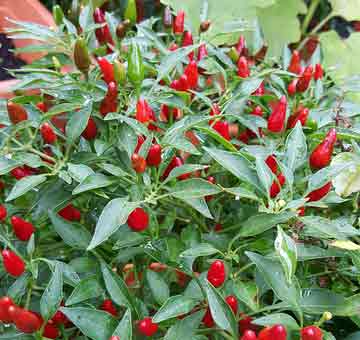
Conclusion
Embracing the cultivation and culinary use of upward-growing peppers encapsulates a journey of discovery, flavor, and community. These vibrant plants offer more than just aesthetic appeal or a spicy kick to your dishes; they represent an exploration into the diverse and rich tapestry of the natural world. Gardening enthusiasts and culinary aficionados alike find joy in the unique characteristics and flavors that these peppers bring to the table and the garden.
So, I encourage you to embrace the challenge and the joy of growing upward-growing peppers. Experiment with different varieties, push the boundaries of your culinary repertoire, and share your journey with others. In doing so, you not only contribute to a vibrant community of gardening enthusiasts but also celebrate the diversity and richness of nature’s bounty.
FAQ: Peppers That Grow Upwards
Q: What are upward-growing peppers?
A: Upward-growing peppers are unique varieties of peppers whose fruits grow upwards, pointing towards the sun, rather than hanging down. This distinctive growth pattern not only adds visual interest to your garden but can also have practical benefits, such as easier harvesting and less susceptibility to soil-borne diseases.
Q: Can upward-growing peppers be grown in containers?
A: Absolutely! Upward-growing peppers are well-suited for container gardening. Choose a pot with adequate drainage and ensure it’s large enough to accommodate the plant’s root system. Container gardening allows for greater control over the soil and moisture conditions, making it a fantastic option for urban gardeners or those with limited garden space.
Q: How much sunlight do upward-growing peppers need?
A: Like most pepper varieties, upward-growing peppers thrive in full sun. They should receive at least 6-8 hours of direct sunlight daily to promote healthy growth and fruit production. If you’re growing peppers in a region with less intense sun, maximizing light exposure will help achieve the best results.
Q: What’s the best way to water upward-growing pepper plants?
A: Water your pepper plants deeply and consistently, aiming to keep the soil evenly moist but not waterlogged. Over-watering can lead to root rot, while under-watering can stress the plant, affecting yield and health. Using a mulch layer can help retain soil moisture and regulate temperature.
Q: How do I choose the right upward-growing pepper variety for my garden?
A: Consider your climate, taste preferences, and how you plan to use the peppers. If you enjoy cooking and want a bit of heat, look for varieties like Tabasco or Fresno. For ornamental purposes, varieties like the Purple Tiger pepper offer stunning visual appeal. Research the growth habits and care needs of different varieties to find the best match for your garden.
Q: Can I grow upward-growing peppers from seeds?
A: Yes, growing upward-growing peppers from seeds is a rewarding process. Start seeds indoors 6-8 weeks before the last frost date in your area. Use a seed starting mix and keep the soil warm and moist. Once seedlings have developed their first true leaves, they can be transplanted to larger pots or directly into the garden after hardening off.
Q: Are there any pest management tips for upward-growing peppers?
A: Keeping your garden clean and monitoring for pests regularly can prevent infestations. If you encounter pests, such as aphids or spider mites, using a mild soap solution or neem oil can be effective treatments. Encouraging beneficial insects, like ladybugs, can also help control pest populations naturally.
We’d love to hear your experiences or tips on growing upward-growing peppers! Sharing your insights can help foster a community of gardening enthusiasts keen on exploring the beauty and bounty of these unique plants.
For further exploration of gardening articles, kindly visit our webpage: Home Garden
17 Fastest Growing Cactus Species for Your Thriving Garden
Poa Annua vs Crabgrass Invaders in Your Lawn (Identification & Control Guide)
Red Creeping Thyme Texas Tough & Fragrant Groundcover (Fast-Growing!)

